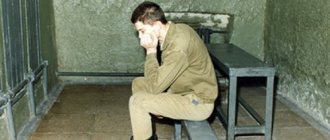Violations of the law can vary widely. The main characteristic of a crime is the severity of the act committed, but there are other important features. Article 15 of the Criminal Code of the Russian Federation classifies crimes into simple and more complex, which include a continuing crime.
It can be difficult to establish the beginning and end of such an action, which can cause certain difficulties, especially when establishing the details of a violation of the law.
Some crimes can “survive” the political system, be inherited and even transformed over time into a legalized type of activity, which is why it is so important to be able to promptly identify and suspend ongoing acts that violate existing laws.
What it is
In legal practice, continuing crimes are not uncommon. Many violations of the law can continue for years and often end only with the death of the person who violated the law.
Free legal consultation
+8 800 100-61-94
It can be quite difficult to establish the fact of a violation of the law that continues over time, but assigning it to a certain category does not present any difficulties. Crimes of this type are violations of the law, which are manifested in the commission of any actions with subsequent prolongation.
The category of violations of existing laws that continue over time includes not only actions, but also inactions of both officials and ordinary citizens. For example, illegally leaving a place of work can lead to extremely dangerous situations, which often lead to death or damage to property.
Failure to report to law enforcement agencies about an impending terrorist act can also be regarded as a continuing violation of the law, since such operations are often carefully planned and their detailed study can continue for a long time.
Important! It is possible to break the law with the “effect” of prolongation even when subpoenas to court or the military registration and enlistment office are ignored.
General principle of operation of criminal law over time
Note 1
The effect of criminal law in time is the possibility of applying normative legal acts of criminal law depending on the time when the crime was committed.
The general principle of the functioning of criminal legislation over time is formulated in Part 1 of Art. 9 of the Criminal Code of the Russian Federation. Issues related to the time limits of criminal legislation are especially relevant during the period of law reform, when new regulations are adopted and “old” laws that do not meet the requirements of new political, economic, and social conditions are terminated.
In judicial and investigative and prosecutorial practice, quite difficult problems arise related to the contradictions of the previously in force and new criminal legislation. If one law was in force when committing a crime, and another was in force during the investigation of the circumstances of the crime, then, as a general rule (Part 1 of Article 9), the law that was applied when the criminal act was committed is applied. Under the new law, crimes committed after the law came into force are classified.
Are you an expert in this subject area? We invite you to become the author of the Directory Working Conditions
Criminal acts that were committed before the new law came into force must be classified under the old law, despite the fact that the investigation or trial was carried out during the period of application of the new law. This rule applies to completed and unfinished crimes. No more severe punishment may be imposed than that which would have been imposed under the old legislation.
In modern conditions, the rules of criminal legislation provide for fundamental constitutional provisions that manifest the principles of humanism and justice, democratization, the implementation of which is of utmost importance for the protection of the rights and freedoms of citizens, strengthening law and order and the rule of law in the country. In criminal law, formal and material elements of crimes are distinguished. Formal elements of crimes are completed from the moment of a criminal act (or inaction), material ones - from the moment the consequences of this act occur.
Finished works on a similar topic
Coursework The effect of the criminal law in time 450 ₽ Abstract The effect of the criminal law in time 280 ₽ Test work The effect of the criminal law in time 250 ₽
Receive completed work or specialist advice on your educational project Find out the cost
Laws eliminating crime and punishable actions:
- reduce the list of criminal acts for which responsibility can begin from the age of 14 (Article 20);
- limit responsibility for the process of preparation for a crime, an attempt on it (Article 30);
- supplement the list of circumstances that exclude criminal liability;
- introduce additional signs of a crime that determine the onset of criminal liability and have retroactive effect.
Additional features include: indication of special features of the subjects of the crime; establishment by law of administrative prejudice; the presence of certain motives or goals among the subjects of the crime; the onset of the consequences of the act specified in the new law, etc. A criminal law mitigating punishment is considered to be a law that reduces the maximum and minimum limits of a certain type of punishment compared to the current law.
Examples
In judicial practice, a significant number of violations can be classified as ongoing over time. The most typical violations of the law are :
- Non-payment of alimony.
- Illegal trafficking of precious metals and minerals.
- Hostage taking.
- Illegal possession of weapons.
- Escape from prison.
- Illegal possession of drugs.
- Failure to comply with a court sentence.
- Concealment of violations of the law.
- Evasion of service.
- Unauthorized leaving of the place of duty.
For many crimes, the beginning of the illegal act can be easily determined. For example, leaving a military unit or taking hostages in public places. Failure to comply with a court sentence is also a violation of current legislation, which can be classified as a lasting violation, with a clearly established starting time.
The end of ongoing violations can be initiated by the violator himself . If a person who was wanted due to non-payment of alimony pays off the debt on his own, then the ongoing violation of the law can be completely stopped at that moment.
Other types of crimes that continue over time can also be easily stopped if a person, on his own initiative, contacts law enforcement agencies. In this case, he can count on a more lenient sentence in relation to the unlawful acts committed.
Continuing crimes may be the inaction of officials. For example, after receiving a bribe, police officers may not pay attention to the illegal actions of individuals for a very long time.
It is also useful to read: Minor Crimes
Conditions for the operation of criminal law over time
Criminal legislation has legal force only when it meets the necessary conditions that relate to the time limits of such action.
Conditions for the operation of criminal law in time:
- must be adopted in compliance with all the requirements of the articles of the Constitution. On this topic, we have already completed the course work
. Functions of the Constitution in more detail; - must be properly published for public information;
- must fully comply with the Constitution and federal constitutional laws. We have already completed coursework
. Legal protection of the Constitution of the Russian Federation in more detail; - should not conflict with international agreements (generally recognized norms and principles of international law, treaties are part of the Russian legal system);
- cannot be no longer in force, since this causes the termination of its validity (the exception is situations in which the commission of a criminal act occurred during the period of validity of the law that has lost force).
Current regulatory legal acts of criminal legislation may lose force due to the following conditions: replacement of one law with another; repeal of the law; expiration of the law; exclusion of special circumstances and conditions that led to the publication of the law.
In practice, different approaches are used to determine the conditions under which a law loses legal force. It is important to regulate the conditions and procedure for terminating criminal laws.
Concept of continuing crime
A continuing crime has several differences from a continuing crime, although in terms of its temporal scope it may be identical to this type of violation of the law. The main distinguishing feature of such a violation of the law is the repetition of illegal actions.
If a continuing crime is often committed only once, for example, desertion from an active military unit, then a continuing crime is periodically renewed.
A continuing type of violation of current legislation may include the receipt of bribes by law enforcement agencies in the form of monthly payments from entrepreneurs who operate in areas under their control.
Reference! The commission of various illegal acts by one person over a long period of time cannot be considered a continuing crime. In such cases, the citizen will be convicted for each episode in aggregate.
Everything about criminal cases
All materials about the totality of crimes
Continuing crimes
(Note: We recommend reading about a few similar terms: Aggregate, continuing, lasting
crimes - what are their differences and practical meaning).
| Normative base - paragraph 21 Plenum No. 24 totality and continuation - what is the difference (in bribe cases) - paragraph 16 Plenum No. 29 totality and continuation - what is the difference (in cases of theft) - paragraph 54 Plenum No. 58 punishment for continuing or continuing - according to the totality of sentences ( - — clause 8 Plenum No. 16 single intent, one continuing crime (sexual crimes) |
Continuing crimes
Continuing crime - several
, and there is
only one
. Several identical actions are performed.
Example: today he stole from a neighbor’s garage, tomorrow he visited again and stole something else. This will be a continuing crime (one crime, not two). But if tomorrow you commit a theft not from the same garage, but from the garage of another neighbor, then there will no longer be a continuing crime, but a totality
(not one crime, but two).
(You can see specific examples of articles under which continuing crimes occur in practice above; all the Plenums of the Armed Forces where such a concept occurs are indicated there).
Important
: in the above example, in the first case the punishment will be less, in the second - more (i.e. a continued crime - punished more leniently).
In what cases does the court classify a crime as continuing?
CANONICAL formula
| By “canonical formula” we mean the same definition repeated in judicial practice. A formulation that regularly appears in court decisions (moreover, it is repeated literally word for word): “According to the meaning of the law, crimes that are continuous are those that consist of a number of identical criminal acts committed, as a rule: - through minor time interval, - in the same environment , - aimed at a common goal , and constituting in their totality a single crime. In a continuing assault, the acts of a criminal offense are interconnected: - objective circumstances , — place , — time , — way committing a crime, - as well as the subject encroachments." As you can see, there is a set of circumstances that need to be applied to your specific case - the more matches with this formula, the higher the chance of qualifying as a continuing crime. |
Why continuing crimes are good
(for guard)?
Because a conviction for 1 crime (continued) will always be more profitable than a conviction for 2 crimes (cumulative). (When taken together, "partial addition" applies in most criminal cases, see Three Rules
penalties: absorption, partial addition, complete addition).
Trial courts are not always able to immediately distinguish ongoing crimes from the aggregate
crimes. This provides opportunities for a reduced sentence in higher courts
POSITIVE examples
Case No. 77-2068/2020
Example
- the totality of crimes was refuted, reclassification into a single crime (which resulted in a reduced sentence). See the link for reasons for requalification.
ILLUSTRATION (Determination of the Second Court of Cassation dated September 14, 2021 N 77-2834/2021)
The person was convicted of a combination of 5 separate crimes (drug sales). But the court of cassation reclassified them into 1 continuing crime.
«if the culprit has the intention of selling everyone
the narcotic drugs he has, and for the purpose of their subsequent sale, he commits such actions in
several stages
; what he has done does not form a set of crimes.
Having purchased the drug, on the same day, he placed a total of 5 caches. an attempt to sell drugs by placing them in certain places (stashes) in a short
period of time cannot indicate that he has committed several crimes.
These circumstances indicate that all actions related to the sale of the narcotic drug purchased by him were covered by a single
intent
."
NEGATIVE example
ILLUSTRATION (Determination of the Second Court of Appeal dated August 21, 2020 N 55-452/2020)
O. was convicted of a combination of 2 crimes:
- first: drug sales;
- second: in two weeks
sold drugs
to the same
buyer.
«given that O. acted with renewed vigor
the intent that arose, with the use of
various
hiding places, on
different
days, the court of first instance correctly qualified what was done as a set of crimes, and not as 1 continuing crime, grounds for qualifying the actions of the convicted person for 2 crimes
.”
As can be seen from this illustration: despite similar circumstances (the same buyer, the same methods of distribution), the court classified it as 2 separate crimes.
Return to materials on the totality of crimes
Seek advice
Lasting and ongoing at the same time
Continuing and ongoing crimes can be combined into one illegal act. Such violations of the law may include :
- Theft of any valuables from one owner. Such acts can continue for many years. For example, workers in some manufacturing plants may steal quality ingredients and use cheaper substitutes to prepare the food. To be classified as a crime that continues over time, an optional condition is the theft of identical items. Often, the objects of illegal encroachment are products of varying value, which are taken out of the enterprise for the purpose of home assembly of a device. For example, stealing one part per day will allow you to completely assemble a Lada Kalina car in a garage within one year.
- Repeated receipt of bribes from one citizen. Officials can take bribes only once or carry out illegal activities on an ongoing basis. If an entrepreneur has to constantly pay money for the preferences provided to him, then in this case such actions can also constitute a continuing crime.
- Rape, which is periodically committed by a certain person against one person, also falls under this category of offenses.
Attention! The cessation of continuing ongoing crimes can also be initiated by the offender himself (turning himself in) or by his arrest by law enforcement agencies. The statute of limitations for such cases is determined from the moment the criminal acts cease.
Long-term crimes can continue for a considerable time, so the damage from such actions can amount to millions and billions of rubles. In addition to financial losses, the state may incur reputational costs, because representatives of foreign companies often have to deal with corrupt officials and the police.
The application of statutes of limitation and amnesty depends on the nature of the crime.
Establishing the nature of the crime—continued or ongoing—is necessary not only for correct qualification (for example, distinguishing a continuing crime from an aggregate crime), but also for resolving a number of other important issues: the application of statutes of limitations, amnesty, sentencing, etc.
Calculation of the statute of limitations for a continuing crime
Recognition of an act as a continuing crime affects the calculation of the statute of limitations (Article 83 of the Criminal Code of the Russian Federation).
For continuing crimes, the statute of limitations is calculated from the moment the crime actually ceases, both at the will of the perpetrator and for reasons independent of his will (detention, confession).
Application of amnesty for ongoing crime
Recognition of a crime as ongoing affects the application of the amnesty act (Article 84 of the Criminal Code of the Russian Federation).
An amnesty act usually applies to criminal acts committed before its adoption or entry into force.
When committing ongoing crimes, the amnesty is applied if the act was stopped before the entry into force of this act. However, exceptions to this rule are possible, established by the amnesty act itself. In other words, an amnesty can be applied to a perpetrator (if it applies to that person) only if the person was detained or turned himself in before the amnesty decree was issued.
Law on the time of commission of criminal acts
The time when the violation of the law was committed is not often mentioned in modern legislation. It can be found as a characteristic feature of the objective side of the crime committed. Here are a few articles where the time indicator is mentioned and important:
- Art. 106 of the Criminal Code provides for serious punishment for a mother for killing a baby during labor or after its completion.
- Art. 331 of the Criminal Code defines and discloses the fact of criminal activity directed against the statutes and rules of military service. Crimes committed during military operations are listed here.
- Art. 334 of the Criminal Code - here responsibility is prescribed for manipulations of a violent nature that were manifested in relation to the head of military service during the period of his performance of his duties.
The time of the criminal act committed is a special optional sign of the objective side of an act dangerous to society. It can influence the level of encroachment carried out. In such a situation, the parameter will necessarily be taken into account and give the punishment the necessary individualization.
For example, for theft, the period when it was committed is not important. But hooligan actions carried out during the organization of mass events significantly increase the level of danger. This factor cannot be ignored when individualizing the punishment prescribed by law.









